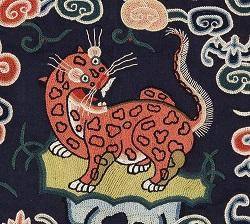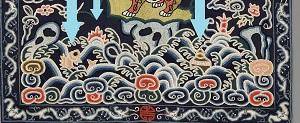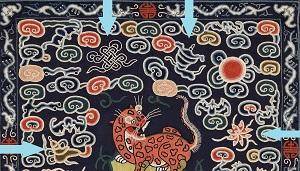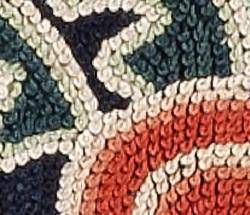Leopard, Third Rank Military Official
This silk rank badge was worn by a military official during China’s Qing (CHING) dynasty. The style of the badge indicates that its wearer was a military official of the third rank (the smaller the number, the higher the rank). Two ways that we know this is a military rather than a civil official’s badge are the leopard (civilian badges depicted birds rather than animals) and the presence of the sun on the right side of the badge (it appears on the left in civilian badges).
Badges were usually made by men and young boys in commercial establishments, although some were stitched by upper-class women in the households of the officials. Studios that produced badges typically specialized in one or only a few designs and used stencils and templates to produce large quantities of badges more efficiently. Women who sewed them at home were free to be more inventive—within narrow limits.
Rank was very important in Qing dynasty China. The imperial government published rules about how officials should dress and dictated what would go on their rank badges. Almost everything an individual wore was prescribed by his or her rank in society, including these badges. Usually only military and civil officials and their wives were allowed to wear badges, although sometimes these rules were ignored.
Every official wore two badges: one on the front and one on the back of a plain dark coat called a pufu (literally, “garment with a patch”). Women wore the pufu [poo FOO] as well. A woman’s badge was often the mirror image of her husband’s, so that when husband and wife sat together, their animals would face each other. If their animals faced away, it implied disharmony and disrespect.
Badges belonging to military officials are less common today than those belonging to civilian officials.
There are two possible explanations for this. Since civil officials were accorded more respect, men were more likely to buy civil positions once the Qing government began to sell ranks in 1843. Also, after a republican revolution overthrew the Qing dynasty in 1911, many military men feared for their lives and destroyed their badges.
Details

Leopard
The leopard represents the third military rank. The leopard’s body faces one way and its head is turned to face over its shoulder in the opposite direction. By doing this the badge maker can make the leopard’s head face toward the sun disk (always on the right side of military badges), which may represent the emperor. In China, the inferior person sat to the right of his superior. Military men wanted the animals on their badges to face the emperor as a sign of respect—but then their animals would not face their wives’ badges when the couple sat together. Some solved this problem by having the animal’s body turned toward the inferior position (the wife), but the animal’s head twisted toward the superior position (the emperor).

Buddhist Symbols in Water
Among the waves are some of the Eight Buddhist symbols, which signified longevity and protection. From left to right, look for the fish (representing freedom and abundance), wheel of law (symbolizing how Buddhist doctrine leads to perfection), and the conch shell (symbolizing the far-reaching sound of Buddhist teaching).

Buddhist Symbols in Air
Some of the Eight Buddhist symbols can be found in the clouds: the parasol (symbolizing protection and the incorruptibility of the official); the endless knot (symbolizing long life and the infinite wisdom and compassion of the Buddha); the standard or banner (symbolizing victory); and the lotus (a symbol of purity).

Bats and Rebuses
The Chinese language is full of homonyms—for example, the word for “bat,”fu [FOO], is pronounced the same as the word for “blessings.” Therefore, bats have come to symbolize good fortune. Rank badges make playful use of these homonyms in what are called rebuses, where a word or phrase is represented by a picture or symbol. See the upside-down bats? The word for “upside-down” is dao [rhymes with COW], which also means “arrived.” Combined with fu, this rebus could be read as “blessings have arrived.”

Details of Stitching
Nearly all of the embroidery on this square is a stitch known as the Peking knot, also known as seed stitch because the stitches are so small and even. Westerners had another name for this stitch: they called it the “forbidden stitch,” because they believed it eventually ruined the embroiderer’s eyesight.
More Resources
“How To Do” Basic Embroidery Stitches
This video shows how to make a French knot and chain stitch while embroidering a flower. While not about Chinese embroidery, the video shows similar stitches. About 4 minutes.
Making Silk
Learn about the tradition of silk making and how it is done today. This video from the American Museum of Natural History is illustrated with old images of how silk making was done in the past, and has an interview with an expert. About 3 minutes.
Silkworm Care, Part 1
Silkworm Care, Part 2
This two part (each part is about 6 minutes) video features a young boy telling, in detail, how he cares for his silkworms. Great information that might be interesting for students to watch.
Websites
Chinese Rank Badges by Beverley Jackson
This website gives an overview of the purpose and history of the civil and military Chinese rank badges.
Lions and Tigers: Rank Badges for Military Officers
A PDF to print that shows pictures of the different types of military rank badges and explains their symbolism.
Power|Play: China's Empress Dowager
Learn about a recent exhibition at Smithsonian's Sackler Museum of Asian Art about the Empress Dowager Cixi (1835–1908), who was the dominant political figure of China's Qing dynasty.
Books
Vollmer, John E. Ruling from the Dragon Throne: Costume of the Qing Dynasty. Berkley, CA: Ten Speed Press, 2003.
An in-depth look at the dress of the people of the Qing dynasty, focusing on the robes of the imperial court and also their accessories and symbolism.
Jackson, Beverely, and David Hugus. Ladder to the Clouds: Intrigue and Tradition in Chinese Rank. Berkeley, CA: Ten Speed Press, 2002.
A thorough analysis of symbols, styles, and techniques used in rank badges. An exploration of Chinese symbols and customs and the textiles that express them.
Garrett, Valery. Mandarin Squares. Hong Kong: Oxford University Press, 1999.
This book goes in-depth to the symbolism and the function of the rank badges.
Children’s Books
Wang, Qicheng. The Big Book of China. San Francisco: Long River Press, 2010.
A history of China presented in a non-traditional comic-book way, focusing on cultural and military history. Best for ages 9-12.
Baldwin, Robert F. Cities Through Time: Daily Life in Ancient and Modern Beijing. Minneapolis: Runestone Press, 1999.
This book tells the story of China’s history in a story-like narrative with full-page illustrations. It focuses on daily life for the military and civilians. Skips from topic to topic but is a fun read for those with little or no background. Best for grades 4-7.
Friedman, Mel. Ancient China. New York: Children’s Press, 2010.
Fun facts about China and its culture including inventions, military history, traditions and dress. Best for ages 9-12.
Funding for object education resources provided by a grant from the Morgridge Family Foundation. Additional funding provided by the William Randolph Hearst Endowment for Education Programs, and Xcel Energy Foundation. We thank our colleagues at the University of Denver Morgridge College of Education.
The images on this page are intended for classroom use only and may not be reproduced for other reasons without the permission of the Denver Art Museum. This object may not currently be on display at the museum.
